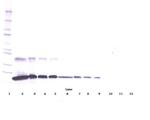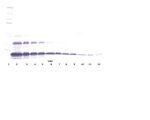Search Thermo Fisher Scientific
FIGURE: 1 / 3
TNFR1 (soluble) Antibody (500-P143-1MG) in WB



Product Details
500-P143-1MG
Species Reactivity
Host/Isotype
Class
Type
Immunogen
Conjugate
Form
Concentration
Purification
Storage buffer
Contains
Storage conditions
Shipping conditions
RRID
Product Specific Information
AA Sequence of recombinant protein: MDSVCPQGKY IHPQNNSICC TKCHKGTYLY NDCPGPGQDT DCRECESGSF TASENHLRHC LSCSKCRKEM GQVEISSCTV DRDTVCGCRK NQYRHYWSEN LFQCFNCSLC LNGTVHLSCQ EKQNTVCTCH AGFFLRENEC VSCSNCKKSL ECTKLCLPQI EN.
Preparation: Produced from sera of rabbits immunized with highly pure Recombinant Human sTNF Receptor Type I. Anti-Human sTNF Receptor Type I-specific antibody was purified by affinity chromatography employing an immobilized Human sTNF Receptor Type I matrix.
Sandwich ELISA: To detect Human sTNF Receptor Type I by sandwich ELISA (using 100 µL/well antibody solution) a concentration of 0.5-2.0 µg/mL of this antibody is required. This antigen affinity purified antibody, in conjunction with PeproTech Biotinylated Anti-Human sTNF Receptor Type I (500-P143Bt) as a detection antibody, allows the detection of at least 0.2-0.4 ng/well of Recombinant Human sTNF Receptor Type I.
Western Blot: To detect Human sTNF Receptor Type I by Western Blot analysis this antibody can be used at a concentration of 0.1- 0.2 µg/mL. Used in conjunction with compatible secondary reagents the detection limit for Recombinant Human sTNF Receptor Type I is 1.5-3.0 ng/lane, under either reducing or non-reducing conditions.
Target Information
TNFR1 (Tumor necrosis factor receptor 1) belongs to the tumor necrosis factor superfamily, and is one of the major TNF-alpha receptors. TNFR1 plays an important role in mediating, in cytokine mediated signaling, positive regulation of the NF-Kb pathway, positive regulation of angiogenesis, and negative regulation of gene expression. The extracellular domain of TNFR1 is also released into the circulatory system as soluble TNFR1 (sTNFR1). In humans, the TNFR1 gene is located on chromosome 12. Anti-apoptotic protein BCL2-associated athanogene 4 (BAG4/SODD) and adaptor proteins TRADD and TRAF2 have been shown to interact with TNFR1, and thus play regulatory roles in the signal transduction mediated by the receptor. Germline mutations of the extracellular domains of TNFR1 were found to be associated with the autosomal dominant periodic fever syndrome, and the impaired receptor clearance is thought to be a mechanism of the disease.
For Research Use Only. Not for use in diagnostic procedures. Not for resale without express authorization.
References (0)
Bioinformatics
Protein Aliases: CD120a; CD120a antigen; MGC19588; n-smase activation assoc. factor; p55; p60; sCD120a; soluble CD120a; soluble TNFR1; sTNF RI; sTNFR I; sTNFR1; sTNFRI; TNF-R1; TNF-RI; TNFR; TNFR I; TNFR-I; tumor necrosis factor binding protein 1; Tumor necrosis factor receptor; Tumor necrosis factor receptor 1; tumor necrosis factor receptor 1A isoform beta; Tumor necrosis factor receptor superfamily member 1A; tumor necrosis factor receptor superfamily, member 1A; tumor necrosis factor receptor type 1; Tumor necrosis factor receptor type I; tumor necrosis factor-alpha receptor
Gene Aliases: CD120a; FPF; MS5; p55; p55-R; p60; TBP1; TNF-R; TNF-R-I; TNF-R55; TNFAR; TNFR1; TNFR1-d2; TNFR55; TNFR60; TNFRSF1A
UniProt ID: (Human) P19438
Entrez Gene ID: (Human) 7132

Performance Guarantee
If an Invitrogen™ antibody doesn't perform as described on our website or datasheet,we'll replace the product at no cost to you, or provide you with a credit for a future purchase.*
Learn more
We're here to help
Get expert recommendations for common problems or connect directly with an on staff expert for technical assistance related to applications, equipment and general product use.
Contact tech support
